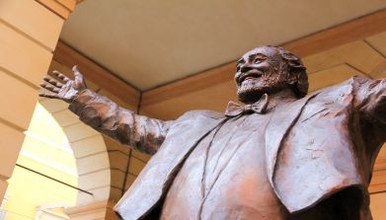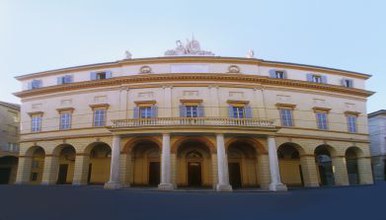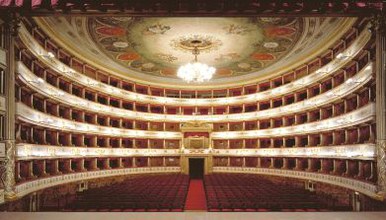Pavarotti - FRENI Municipal Theatre of Modena
In 1838 the Community of Modena decided to build a modern theatre, that could fully meet the representative needs of the city and improve its image.
At the time, Modena was insufficiently served by the old Municipal Theatre in Via Emilia, situated in the building of the former 17th century comedy theater, the "Valentini".
The new construction was entrusted to the ducal architect, Francesco Vandelli, designer of the Foro Boario and the church of S. Giovanni del Cantone. Before starting its project, he visited some of the most important contemporary theatres of northern italy, including those of Piacenza, Mantua and the Scala in Milan. Vandelli studied them and took notes for its work. These sketches represent one of the few graphic documents by the architect of whom no handwritten designs of the municipal theatre are known to exist.
Construction began in May 1838 in the chosen area between Canalgrande, Vicolo Venezia, Fontedabisso and Strada S. Margherita, by demolishing and knocking down twelve houses. Nevertheless, the space was still too small, resulting in a façade of the building taht breaks the symmetry of the houses in Canalgrande.
This characteristic made the building easier to recognize as a theatre from a distance, in fact its view was obstructed by the narrowness of the street where it was erected. After almost four years of work the theatre was inaugurated in the evening of October 3rd 1841, with the opera "Adelaide of Borgogna at the Canossa Castle" with music by Alessandro Gandini. The new Municiapal Theater featured a large portico on the outside to park carriages, numerous service rooms (among which the spacious room for stage decor used until a few years ago), a horse-shoe plan auditorium with four stories, a gallery and a sumptuous ceiling decorated by artists Camillo Crespolani and Ferdinando Manzini.
Since that date the building has not undergone any radical changes. Today it still presents the original neoclassic façade with a flat ashlar portico on the ground floor, architraved windows on the first floor and an attic with smaller windows.
The relief of the central part is marked by four doric columns on which a balustrade of small pillars is set, framing three windows scanned by ionic style pillars. To crown it all, a gable decorated with the Genius of Modena frames the coat of arms of the city.
The façade is embellished by a rich plastic decoration made with rosettes placed on the archivolts on the ground floor, as well as bas-reliefs by Luigi Righi to the sides of the portico and in correspondence to the windows.
The ceiling - from which the large chandelier has been hanging since the introduction of electricity in 1887 - is decorated with ornamentation by Camillo Crespolani and figures by Luigi Manzini, who also made the stuccoes depicting stories of the Genius running along the balconies of the boxes framed by slender pillars. In 1869 the ceiling was repainted by Ferdinando Manzini who suggested the addition of four groups of cherubs.
Ticket office
The ticket-office at the Municipal Theatre is open on Tuesday from 10:00 am to 7:00 pm and on Wednesday, Thuersday and Friday from 4:00 pm to 7:00 pm, on Saturday from 10:00 am to 14:00 and 4:00 pm to 7:00pm.
Guided tours
Guided tours are possible only upon reservation: info@visitmodena.it








